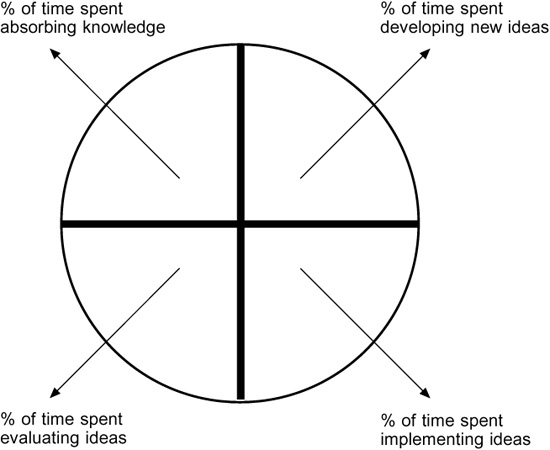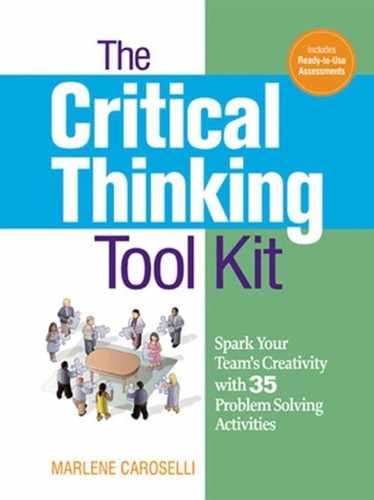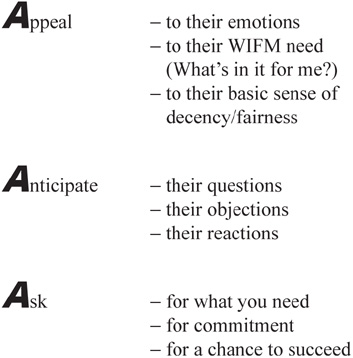#27: The Triple-A Approach
Overview: |
Participants will begin by studying the Triple-A Approach and then using it to formulate a persuasive proposal on a workplace issue. The presentation will be evaluated by other class members. |
Objective: |
To familiarize participants with the Triple-A Approach to presenting information. |
Supplies: |
• Transparency #27-1 |
Time: |
Approximately 30 minutes |
Advance |
Download the transparency. Cut up scraps of paper, six or seven for each participant. |
Participants/ |
Arrange for table groups of five or six to work together. This exercise works well as a session-opener (to illustrate that in training-session teams or on workplace teams or simply in everyday encounters, persuasion skills are indeed valuable) or as a change-of-pace activity that asks participants to critique what was learned thus far and to persuade others to accept their opinions regarding which elements of the instructional content are likely to have most relevance in the workplace. |
Introduction to Concept:
Author Ken Blanchard asserts that “the key to successful leadership today is influence, not authority.” We influence others by our example, to be sure, but also by our words—whether those words are delivered by speaking, by writing, or by the electronic medium. Sometimes, when we observe others who always seem to get what they want, we are envious or puzzled by the apparent magic they exert over others. In truth, though, the persuaders we admire have finely tuned their communication skills.
One tool that will assist you in your effort to make a point and influence others to accept your viewpoint is the Triple-A Approach. It focuses on three factors. [Show Transparency #27-1 now and briefly discuss the elements.]
1. Once participants have had a chance to review the transparency, divide the class into groups of five or six.
2. Assign each group one of the following topics to be developed using the Triple-A Approach. (You may choose other topics that may have special relevance for your participants. Or, if the activity is used as a concluding activity, the different groups will try to persuade others to adopt their point of view regarding which aspects of the training session were the most valuable.)
We should have a dress code at work.
Mondays and Fridays should be “dress-down days.”
Secretaries should receive a percentage of their boss’s annual bonus.
Employees should be able to evaluate their supervisors.
Employees should be allowed to use the Internet for personal business during slow periods.
3. Allow the teams about 20 minutes to write out their arguments and to select a spokesperson to deliver the written remarks.
4. Before or after the spokesperson attempts to persuade the other groups, distribute small sheets of paper. Upon the conclusion of each presentation, ask participants (other than members of the presenting group) to write one word on their papers: “Yes” (indicating the argument was persuasive) or “No” (indicating the argument did not influence their thinking).
5. Collect the scraps and pass them to the presenting group.
Extending the Activity:
1. Show a videotape of a well-known persuasive speech (such as the President’s State of the Union address or a lawyer’s closing argument) and analyze it as a group, using the factors in the Triple-A Approach as the criteria.
2. Invite the top salesperson from a local real estate firm to address the class on the reasons for his or her success in selling.
3. Ask small groups to create an acronym of their own for decision-making.
Workplace Connections:
1. Request that participants identify one individual in their workplace having the toughest decision of all to make. Then recommend that they meet with that person to learn more about the process of decision-making. Suggest that they make notes on the meeting, to be shared with the individual first and later with groups of employees.
2. Employees should reflect weekly on the percentage of time they spent at work absorbing knowledge, the percentage of time they spent developing new ideas, the percentage of time they spent implementing those ideas, and the percentage of time spent evaluating new ideas. A simple graphic will enable them to tell at a glance if they are maintaining a roughly equal division among the categories, such as this one:

Questions for Further Consideration:
1. How much discussion is typically accorded decisions made in your workplace?
2. To what extent are employees invited to voice their opinions?
3. What factors do you take into account as you make decisions at work?
4. In terms of organizational or national history, what poor decisions can you recall prominent people having made? What elements went into the poor decision-making?
5. What works well in preventing “groupthink” from occurring?

